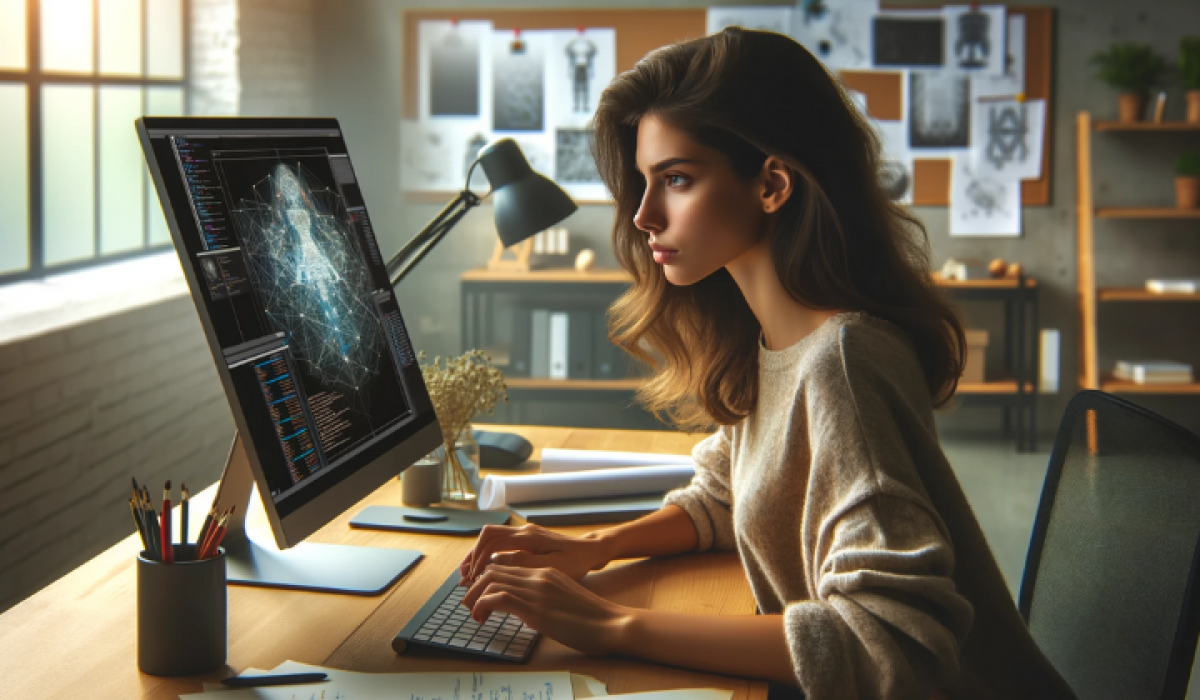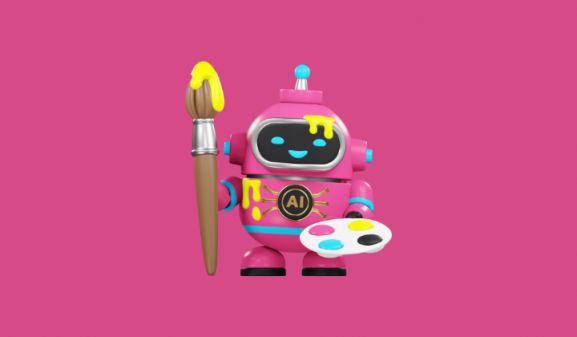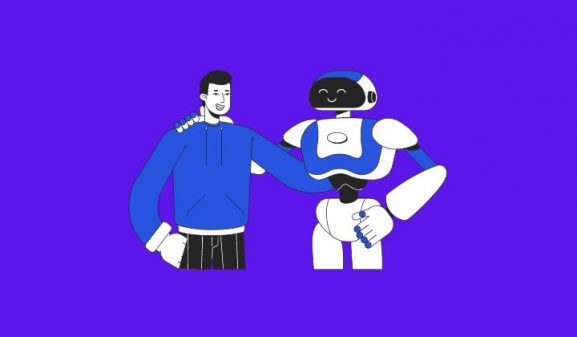One of the industries where artificial intelligence has had the biggest effects is graphic design. Forbes presented the following numbers, which show that between 2023 and 2030, AI is predicted to increase at an annual rate of 37.3%. This quick expansion highlights how AI technologies will become more and more important in the years to come.
Artificial intelligence (AI) solutions facilitate the creation of graphics, enhance image quality, and simplify repetitive graphic-related jobs, allowing experts to work more productively.
We will discuss the application of artificial intelligence in graphic design in this post. We’ll examine the most recent additions to Adobe Photoshop’s feature set and discuss how you can utilise them to improve your workflow.
The Reason Behind Graphic Design?
There are a lot of design kings, and artificial intelligence technologies are utilised in a lot of those areas, including the following:
The creation of landing pages and the development of code for websites are both aspects of web design.
3D modelling, which involves the generation of 3D models in a matter of minutes; motion design, which involves animating images such as cartoons and mascots;
The process of assisting designers in the creation of sketches for automobiles or clothes is known as industrial design.
It is not possible for artificial intelligence to totally replace human designers in any of those professions, despite the fact that AI can be useful. Human designers require originality, good taste, and a deep understanding of different business requirements. Both user experience and user interface design, as well as product design, which rely far less on actual design talents and much more on the understanding of business logic, are not successful areas for artificial intelligence.
However, when it comes to graphic design, AI technologies have a tendency to produce fantastic results while requiring just a small amount of human participation. It is, without a doubt, essential to provide neural networks with the appropriate prompting, and it is not uncommon for it to require both expertise and time in order to get the desired results. On the other hand, the end outcome takes fewer adjustments than is the case in other situations. An example of this would be the fact that MidJourney is capable of producing stunning digital artwork.
The Impact of AI on the Design Industry
Artificial intelligence is having a significant impact on the design industry and is having an effect on everything, from the job of designers to the people who generate visuals.
Currently, a significant number of human designers are modifying their approach to the creation of content. They make use of artificial intelligence to build templates that they can customise, create mockups, and figure out the typeface and colour scheme. This is done rather than developing everything from scratch.
It is also the demand side that is driving the move towards this new state of affairs. According to a survey conducted by Venngage in 2022 regarding visual content, the most popular form of visual content was found to be unique graphics, surpassing stock photographs by a margin of 36.6%.
For the purpose of satisfying this demand for picture generation, graphic designers are searching for ways to integrate artificial intelligence into their workflow and automate jobs that are repetitive. They are, for example, outsourcing jobs to artificial intelligence such as the removal of backgrounds, the modification of face expressions, and the enhancement of fundamental photographs.
Likewise, artificial intelligence is proving to be useful for designers throughout the research and exploration phase of the design process. It is possible for them to employ artificial intelligence to generate dozens of templates from a single sketch, each of which has variations in colours, forms, or the placement of elements.
In the field of graphic design, artificial intelligence will, in general, result in speedier workflows and fewer repetitive manual jobs. Additionally, this will result in a greater number of consumers having access to individualised designs.
When it comes to designers, this means that they will have more time to devote to the creative process or to working on their portfolio website.
5 Ways Artificial Intelligence will Affect Design in the Years to Come
1. The speed at which images are generated will increase
Software that generates images using artificial intelligence, such as DALL-E 2, is one of the most striking applications of AI in design.
In order to generate images from textual descriptions, this cutting-edge artificial intelligence system has understood the relationship that exists between visuals and the text that is used to describe them.
The only thing you need to do in order to produce an original, one-of-a-kind, and realistic image is to inform DALL-E of your concept in as much detail as you can and then click the “generate” button.
The system enables you to:
An image should be created based on a description using a particular style.
Make modifications to pre-existing photos in accordance with instructions given in natural language.
Make a number of photographs that are either stylistically comparable to the one you upload or that are inspired by it.
OpenAI, the company that developed the system, is already giving access to the tool to a wider number of people from the waitlist. They anticipate accepting more than one million new users over the next couple of weeks. Although DALL-E 2 is not yet open to the general public, OpenAI is actively boosting access to the technology.
DALL-E 2 has a wide range of applications in the fields of design and marketing; hence, whenever it is made accessible to the general public, it is expected to affect the design industry in a significant way.
In point of fact, the earliest instances of applying artificial intelligence for the purpose of designing images have already occurred. For example, digital artist Karen Chen used DALL-E 2 to produce a magazine cover for Cosmopolitan.
2. Image enhancement is about to get even better.
Photo editing is not a new concept.
In truth, the history of photo editing and modification dates back to 1841, when Calvert Richard Jones took a shot of five Capuchin monks and didn’t like the results.
Four of the monks were grouped in a group in the shot, while the fifth was in the distance, a few feet behind them, destroying the composition’s structure.
To fix this photo, Jones used Indian ink to blacken the figure of the fifth monk on the negative of the photograph.
Today, photo editing is almost never done by hand; designers employ advanced software to correct flaws in a photograph.
Nonetheless, the goal remains the same: to increase the photo’s quality, remove faults, and restore missing elements of an image if they exist.
3. Background removal will no longer be difficult.
Whether you inquire of a design novice or an expert with years of experience, their responses to the query “How do you feel about background removal?” will be virtually identical.
A significant negative attitude towards background removal is observed in nine out of ten instances. Because, in all honesty, it is a significant inconvenience.
Regrettably, life is not an ideal world in which every object depicted in photographs exists against a monochromatic, contrasting background.
However, objects are “stuck” to the background in the vast majority of instances. Undoubtedly, the process of eliminating the background from a photograph featuring an individual adorned with curly or unruly hair would consume a substantial amount of time.
Historically, this was the prevailing situation. With the assistance of AI technology, background removal is now effortless and rapid.
4. Virtual influencers may become more accessible
Virtual influencers are gaining more and more popularity as the world continues to deepen its descent into the Metaverse, which is the sphere of digital technology.
When compared to traditional influencer marketing, virtual influencer marketing offers a number of advantages, including the following:
Increased command over one’s reputation
Brands are able to maintain a clean reputation because they are able to more effectively regulate the values and messages that they represent through the virtual influencers that they collaborate with.
Increased levels of participation
There is a general trend towards virtual influencers having higher engagement rates than conventional influencers. The following are some of the reasons that people subscribe to virtual influencers on the internet, according to the statistics:
The stuff that virtual figures share online is of interest to 26.6% of Internet users.
- 18.6 percent of people are captivated by the narrative.
- 15.5% of respondents said that they are inspired by virtual influencers.
- 15 percent of people find new music through the use of virtual influencers.
- 12.1% approve of the appearance of the avatar.
- On the internet, 11.8% of people enjoy interacting with digital characters.
Through the use of virtual influencer marketing, you may get a competitive advantage and represent your company in the market as one that is in the forefront of technology, fashion, and innovation.
A few years ago, this particular niche was very small and unoccupied, and it was dominated by a number of extremely well-known celebrities such as Lil Miquela, Guggimon, and Shudu.
Currently, however, the situation is undergoing a rapid transformation; an increasing number of businesses are cultivating their very own virtual influencers in order to promote their brand within the Metaverse.
As an example, the luxury fashion brand Prada developed the virtual influencer Candy in order to make her the new face of the Prada Candy perfume:
It is no longer necessary to be a large company with a substantial budget in order to establish your own virtual influencer, as technology continues to progress.
You are able to create a hyper-realistic snapshot of a human being that has never been seen before thanks to artificial intelligence face generating techniques such as TL-GAN:
It will no longer be necessary for designers to spend a significant amount of time painting a realistic image of a human being in order to represent a business online. Instead, they will be able to simply feed a few of parameters into the AI system, and they will have a new face for each subsequent campaign.
5. Everyone can be an artist
Artists all over the world, be careful: there is now an AI tool that can take simple brushstrokes and turn them into realistic landscapes.
Yes, you read that right. Software can now turn your doodles into pictures that look like they were made by a professional, even if you were never good at drawing or painting.
NVIDIA Canvas is currently restricted to landscapes only, but we anticipate that in the future, an increasing number of tools will enable users to create images of any kind.
Although this will eradicate the lower end of the market, entry barriers will be eliminated, allowing anyone with access to AI tools and a creative concept to successfully develop their idea.
In order to remain competitive, an increasing number of designers will need to contribute to multidisciplinary contexts with supplementary knowledge and skills, which may result in the development of increasingly exotic specialisations.
You must simultaneously bear in mind that not all ideas are acceptable. In order to accomplish something significant, one must possess a creative vision. Furthermore, in reference to the subject matter of proficient designers.
Implications that artificial intelligence will have in the future on graphic design
It is difficult to predict exactly how artificial intelligence will affect graphic design, but we may anticipate that the changes will be significant.
The levels of sophistication of AI art continue to rise. In a survey conducted in 2023 with fifty-four undergraduate students from Yale, the respondents were only able to differentiate between images generated by artificial intelligence and those made by humans 54% of the time. It is possible that it will get much more challenging in the near future.
It is reasonable to anticipate the following modifications, at the very least:
The use of artificial intelligence in the process of brainstorming: An increasing number of designers may increasingly rely on AI to transform a single sketch into several mockups or alternative concepts.
Quick editing capabilities: It is possible that users will find themselves employing AI tools on a frequent basis to edit images and artworks on the fly.
Artificial intelligence (AI)-assisted design: Designers may include AI into their design process by relying on AI for menial jobs, discovering suitable colour combinations, and obtaining design inspirations.
In the event that the laws governing image copyrights undergo a change, we might anticipate even further modifications. If you want to utilise the work for commercial purposes, however, it is best to focus on how artificial intelligence may save time and automate elements of the design workflow rather than swiftly making art using the programmes. This is especially true if you want to use the work.
Keeping up with these trends is beneficial, regardless of whether you are a designer or an entrepreneur who is interested in gaining benefits from deep learning. This is true even if you do not intend to employ artificial intelligence yourself.
An example of this would be if you own an online jewellery business, you might rely on AI graphic design to alter your product photographs in batches.
Concluding reflections
Although AI in graphic design is a nascent idea, integrating the tools may not be as challenging as you perceive.
In addition to producing graphics, you have the ability to automate operations, generate mood boards, and swiftly modify already images.
Additionally, artificial intelligence can be employed to enhance your portfolio by including product photographs into your ecommerce store. With the help of AI, the possibilities of what you can imagine are now limitless. Your potential is boundless, constrained solely by the limits of your imagination.
If you have a desire to host your AI-generated designs or establish your AI-based marketing company, as Bluehost provides a wide range of cost-effective hosting choices. If you like a low-maintenance method similar to the capabilities provided by AI, we recommend considering our WordPress hosting service.




Pingback: Benefits of Artificial Intelligence for Businesses 2023
Pingback: How To Create A Hero Animation in SwiftUI?
Pingback: Importance of Artificial Intelligence in Our Daily Life 2024